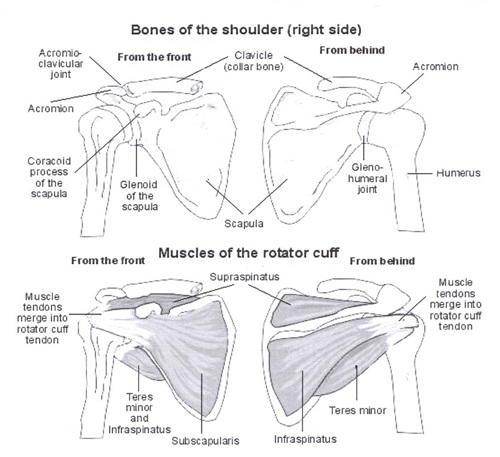Most people find their symptoms settle without the need for an operation.
Non-surgical treatments (conservative care)
Injections
These are given into the sub-acromial space. They are usually a mix of steroid and local anaesthetic. Increased pain is sometimes felt for the first 24hours, but usually settles and improves symptoms.
Physiotherapy
If you are referred to physiotherapy the physiotherapist will:
assess your shoulder, and give you advice and an exercise programme to work on. These tend to include:
strengthening exercises for the muscles around the shoulder blade and rotator cuff, and postural exercises
You may find these exercises are hard work and you may feel the shoulder stretch but they should not be painful.
'self-help' ideas:
This is about changing your activities. The aims are:
1. To reduce the stress on the tendon(s) so that your body can try and heal
2. Break the pain cycle
1. To reduce the stress on the tendon
Try to stop the activity that causes pain or try to find a different way of doing it. For example you may find it very difficult to raise your arm up to put something in the cupboard. To avoid this you could try using steps to raise yourself up or keep your elbow in and raise your arm and palms upwards. This may feel awkward at first but if it reduces the pain it might be worth practicing.
Working on your posture is very important to your shoulder blade, which makes up half of your shoulder joint. Try to look at your shoulder blade position in the mirror. If it is different on the affected side then try some of the exercises in the leaflet to improve its position.
If you are involved in a sport or profession where repetitive movements are constant then seek advice on
technique or posture. Again, the exercises will help you stretch out and strengthen some of the important areas in your shoulder.
2. Breaking the pain cycle
Some of the ideas in section 1 should help reduce the pain but using the following may help.
- pain medication - it is important to discuss this with your pharmacist or doctor. They can be effective at controlling bouts of pain. They can also stop the pain getting so bad that you are not able to do everyday tasks
- using anti-inflammatory cream or gel over the area. Again, it is important to check with your pharmacist or doctor to see if you are able to use these. These can be effective as they target the area where the pain is.
- using a wet ice-cube and massaging over the tender area. Try for 10 minutes watching that the ice-cube stays wet and you avoid an ice burn. Always allow the skin to return to normal temperature before putting the ice on again.
If you have not already tried some of these ideas it is worth doing so now. Use the ones that suit you. This could make a big difference to your everyday life.
Trying the exercises below is also useful - follow the advice and monitor your symptoms.








